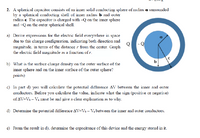Question
it is not an exam can you stop saying honor code pls thank u.

Transcribed Image Text:2. A spherical capacitor consists of an inner solid conducting sphere of radius a surounded
by a spherical conducting shell of inner radius b and outer
radius e. The capacitor is charged with –Q on the inner sphere
and +Q on the outer spherical shell.
a) Derive expressions for the electric field everywhere in space
due to this charge configuration, indicating both direction and
magnitude, in terms of the distance r from the center. Graph
the electric field magnitude as a function of r.
Q -Q
b
b) What is the surface charge density on the outer surface of the
inner sphere and on the inner surface of the outer sphere?
points)
c) In part d) you will calculate the potential difference AV between the inner and outer
conductors. Before you calculate the value, indicate what the sign (positive or negative)
of AV=Vo – Va must be and give a clear explanation as to why.
d) Determine the potential difference AV=V – Va between the inner and outer conductors.
e) From the result in d), determine the capacitance of this device and the energy stored in it.
Expert Solution
This question has been solved!
Explore an expertly crafted, step-by-step solution for a thorough understanding of key concepts.
Step by stepSolved in 3 steps with 4 images

Knowledge Booster
Similar questions
arrow_back_ios
arrow_forward_ios